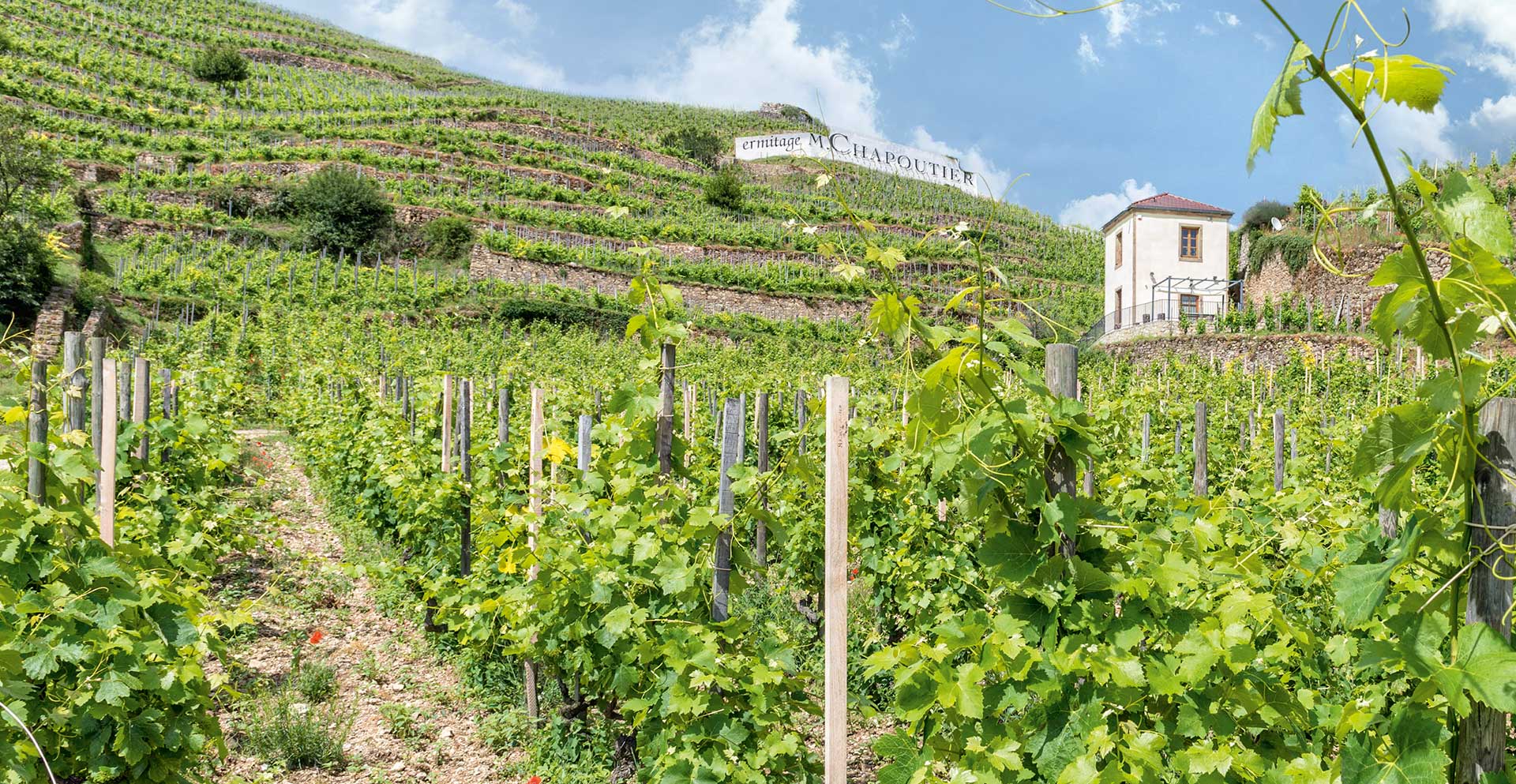Rhone Valley : 2022, an astonishing and unique sunny vintage
In the vineyard
01 February 2023
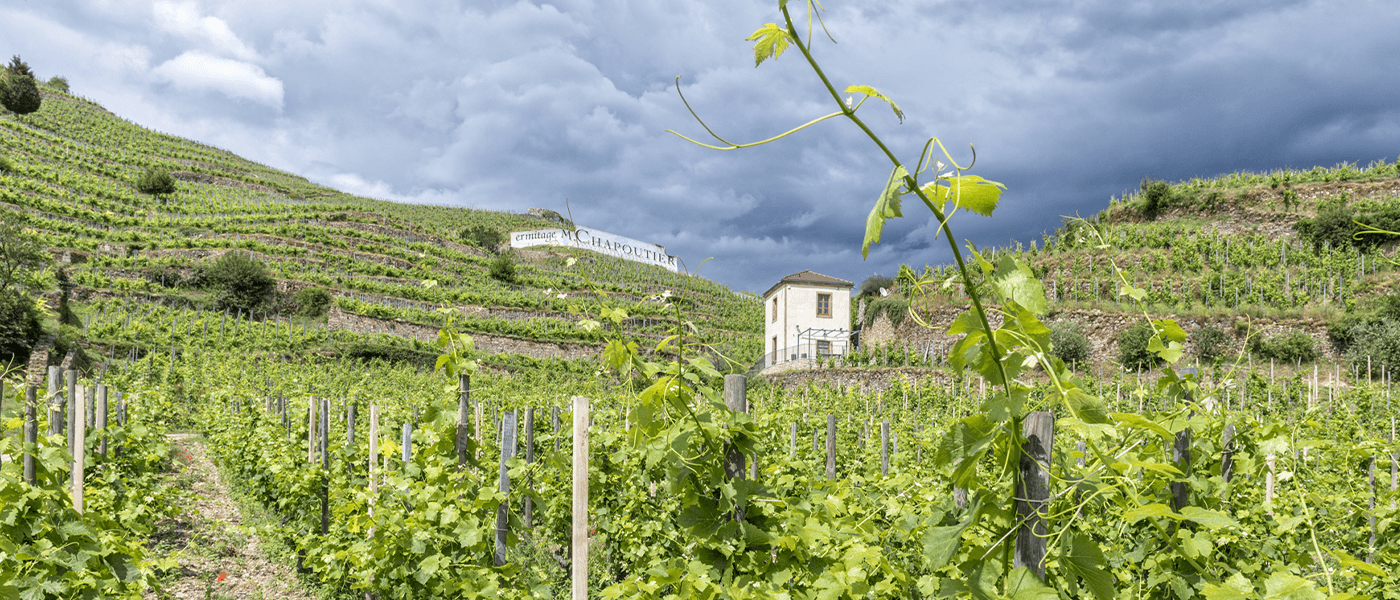
We had to “keep calm and carry on” throughout this season of drought and heat to constantly adapt the winegrowing work right up to the last minute; responding fast to curb the vegetation when the welcome rains arrived and remaining patient to allow the grapes to reach full maturity. All this made 2022 an astonishing vintage that, as it turned out, was more luminous than sunny.
January started off chilly and winter set in with temperatures that regularly dropped to below zero. After repairing the stone walls on the hillside vineyards, it was the turn of the emblematic walls of l’Hermitage to be scraped and repainted ready for the new winegrowing season.
We carried out the first restorative pruning on the vineyard plots in Ampuis that had suffered some frost damage in 2021. Then, in February, we quickly set about pruning the vines on all the Domaines. We also invited Inès, a spirited, young Comtoise mare, to take her first steps in the Hermitage vineyards.
Spring came in timidly, in slow motion. This was the first indication of a shortage of rainfall, confirmed by the already reddish-coloured sedums (an indicator of a lack of water). Only 70mm of rain fell in Tain l’Hermitage over the first quarter, while temperatures continued to rise as the days went by. However, a cold snap at the start of April, when the first leaves were opening in the Le Méal vineyard, had us worried about a potential black frost. In the end, it produced nearly 50mm of rainfall on the Hill, stimulating the vine’s growth; nature was finally getting a move on! Meanwhile, in the Southern Rhône Valley, we continued to wait for the rain, which never came… The landscape turned green, but on the west side of Les Bessards, timid shoots were emerging, giving the vines a strange, miniaturised appearance. Nevertheless, small inflorescences appeared on the vine. The harvest was also already looking as if it would be small.
Rarely had we seen such a dry month of May while the heat continued to bear down on the Rhône Valley. There would be just a few drops of water wetting the rain gauge. Temperatures already exceeded 30°C and it was in this hot, sunny weather that the flowering began on 22 May. It was an extremely fast flowering, lasting only a few days, but it was uniform, regardless of the vineyards’ exposures. We quickly did the math and an early vintage, reminiscent of 2020, was forecast.
By the end of May, the Northern Rhône Valley had received a total of 110mm of rain, about three times less than in recent vintages. This was the third lowest level of rainfall since 1959, after 1976 and 2003. The vine’s growth did not really get going again until June when almost 90 mm of rain fell. On 15 June, a first wave of a sub-Saharan heatwave arrived, moving up the Rhône Valley from the south. This was the earliest heatwave ever recorded in France; the temperatures rose (often to around 30-35°C) as did the south wind, which blew regularly over the vineyards, exacerbating the symptoms of drought.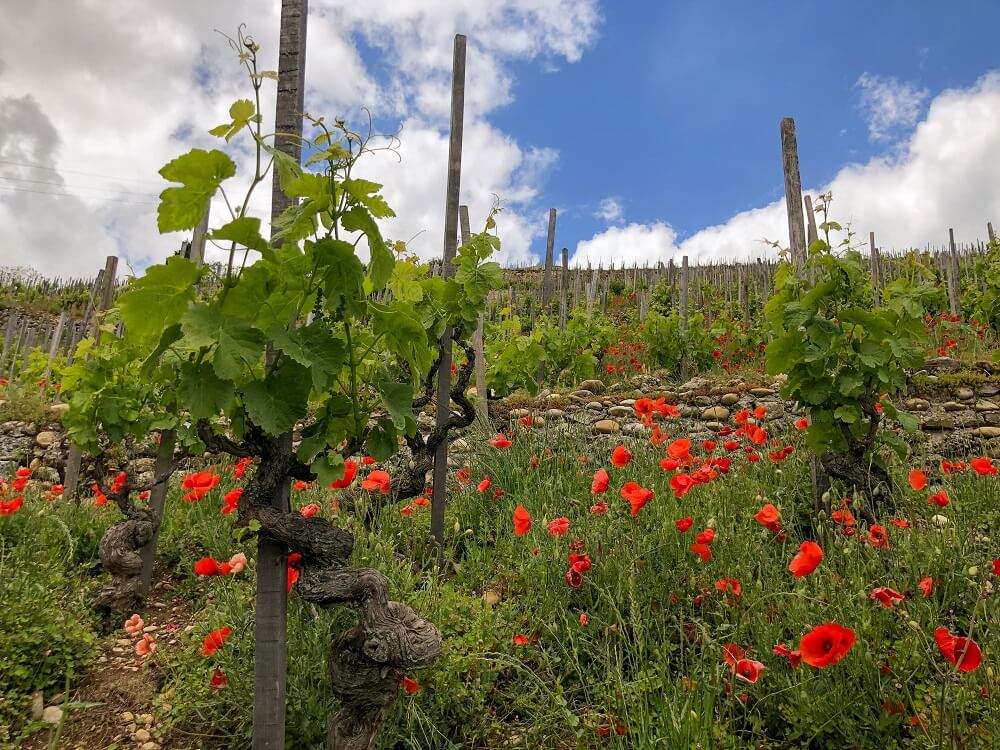
We realised then that we would have to do everything we could to preserve the vine’s foliage in order to protect the nascent clusters and prevent scalding, as we have learned from the last few very sunny vintages. Intensive green work had to be carried out, but topping was kept to a minimum, or even omitted, to ensure that the foilage would provide shade for the clusters and preserve the grapes’ natural acidity. This was all the more important as in some places the vegetation was still barely halfway up the stakes. It was wiser to let nature take its course and to wait. All soil work was also stopped very early on to prevent evaporation. We decided to preserve plant cover, even if it was minimal, to protect the soil from the extreme temperatures. The working day was also disrupted: it started at sunrise and then the work was stopped to wait for the sun to pass over to the Ardèche side putting the hillsides into the shade, before continuing and then finishing at sundown.
A first hailstorm broke over the Mauves area. The vines subsequently recovered from the damage incurred and then the same thing happened in Châteauneuf-du-Pape. But a drop of water is always welcome no matter what!
In the Condrieu area and on the Crozes-Hermitage plains, the fairly large cluster count seemed to want to make up for the upset of the 2021 vintage. To prevent the excessive yield from weakening the vine during these hot spells, we decided that it was best to reduce the size of the crop to allow the remaining clusters to benefit from the vine’s reserves. The rest of the season was to prove us right. In the Southern Rhône Valley, another hailstorm hit, this time in Valliguières (Roc Folassière) and divested us of several hectolitres per hectare in our Côtes-du-Rhône yields.
The Marsanne grapes continued their fruit set as the first leaves finally reached the top of the stakes in the hillside vineyards. On the slopes of Ampuis, the harvest potential looked promising, almost making up for the problems of last year. The first signs of water stress appeared on the hillsides in the places where the bedrock breaks through.
In the first week of July, the veraison was already underway in Les Greffieux (Ermitage). The vine’s growth continued to be earlier than usual and we found ourselves already anticipating the coming harvest. As the region baked in a second heatwave, the apexes continued to grow, showing that the vine had not yet shut down, an indication of the plant’s behavioural and physiological response to its environment. Thanks to the years of biodynamic practice, the vine is becoming stronger and adapting naturally to global warming.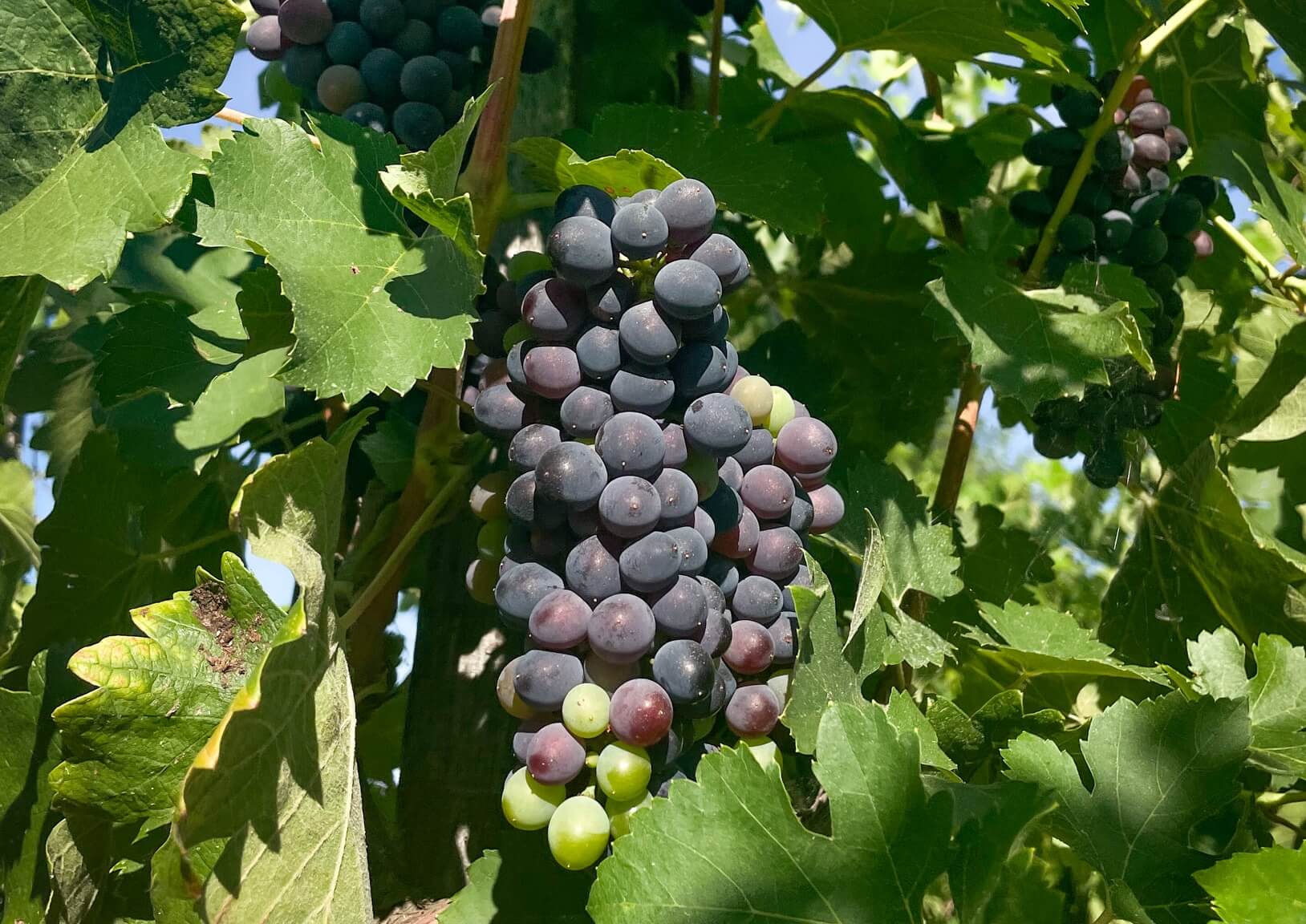
On the eve of 14 July (Bastille Day), despite our best efforts, we saw a few signs of scalding on the Syrah vines growing on the plains. This was due to the sudden rise in temperatures to over 38°C and the scorching late afternoon sun. The winegrowers had to work hard throughout the summer, regularly applying infusions of camomile and yarrow, sprayed at sunset to relieve and preserve the vine’s foliage and prevent the acidity in the grape berries from being burnt away.
However, the water stress was starting to become problematic on the Les Châssis ridge (Crozes-Hermitage) where the pebbles were draining the water too fast. Surprisingly, Le Méal, the most southern of the Hermitage hillsides, was holding up well. It has grown stronger over the years to cope with the effects of the very sunny vintages.
As the heatwave coming up from the south of the Mediterranean continued, we dug some small troughs around the vines, which would enable them to fully benefit from the water that would have to arrive sooner or later. This is an old technique that has been re-introduced for hillside cultivation. The Drôme and Ardèche countryside was as dry as a bone and official decrees of drought were issued. We also did not escape the wildfires that were sweeping across France, as the flames brushed up against one of our plots in Tournon.
Although the rain in June and early July prevented severe water stress, the annual shortfall could no longer be offset and it was clear that yields would be affected. A contrast was emerging between the plains and certain hillsides where the signs of water stress were becoming worrying. The landscape had been dramatically altered by the drought this summer, more than in the winegrowers’ living memory, and more than in 2003 when the green foothills of l’Hermitage contrasted with the granite slopes. Le Grand Bessard, however, remained unperturbed in the midst of it all and the grapes continued to ripen extraordinarily well, the expression of a very fine Terroir !
We were already starting to carry out the first analyses of the grapes’ maturity: the degrees were moderate despite the heatwave and the phenolic maturities were progressing well. Sunday 14 August, some rain at last! This welcome rainfall enabled us to escape the worst effects of the drought and gave us much greater peace of mind in the run-up to the harvest. Very soon, the first signs on the grapes were noticeable.
Unlike the Southern Côtes-du-Rhône area, where a hailstorm passed over the communes of Bédarrides and Châteauneuf-du-Pape, the damage was very significant on the leaves and shoots. The damaged clusters healed quickly thanks to the Mistral wind which then rose and dried everything. The countdown to the harvest was on!
On 19 August, the vine’s growth quickly resumed and young leaves appeared in the Varogne area. The replacements for those that had been damaged started growing and, less than 10 days after the rain, the landscape was transformed, everything was springing back to life! And the ripening of the grapes was also picking up pace as the heat started to dissipate. The harvest began early on Monday 22 August with Esteban (Combe Pilate) and then very quickly moved on to the Marsanne to preserve the acidity. First of all, on the Le Méal hillside and then on the Les Murets hillside (De L’Orée) on Tuesday 23 August.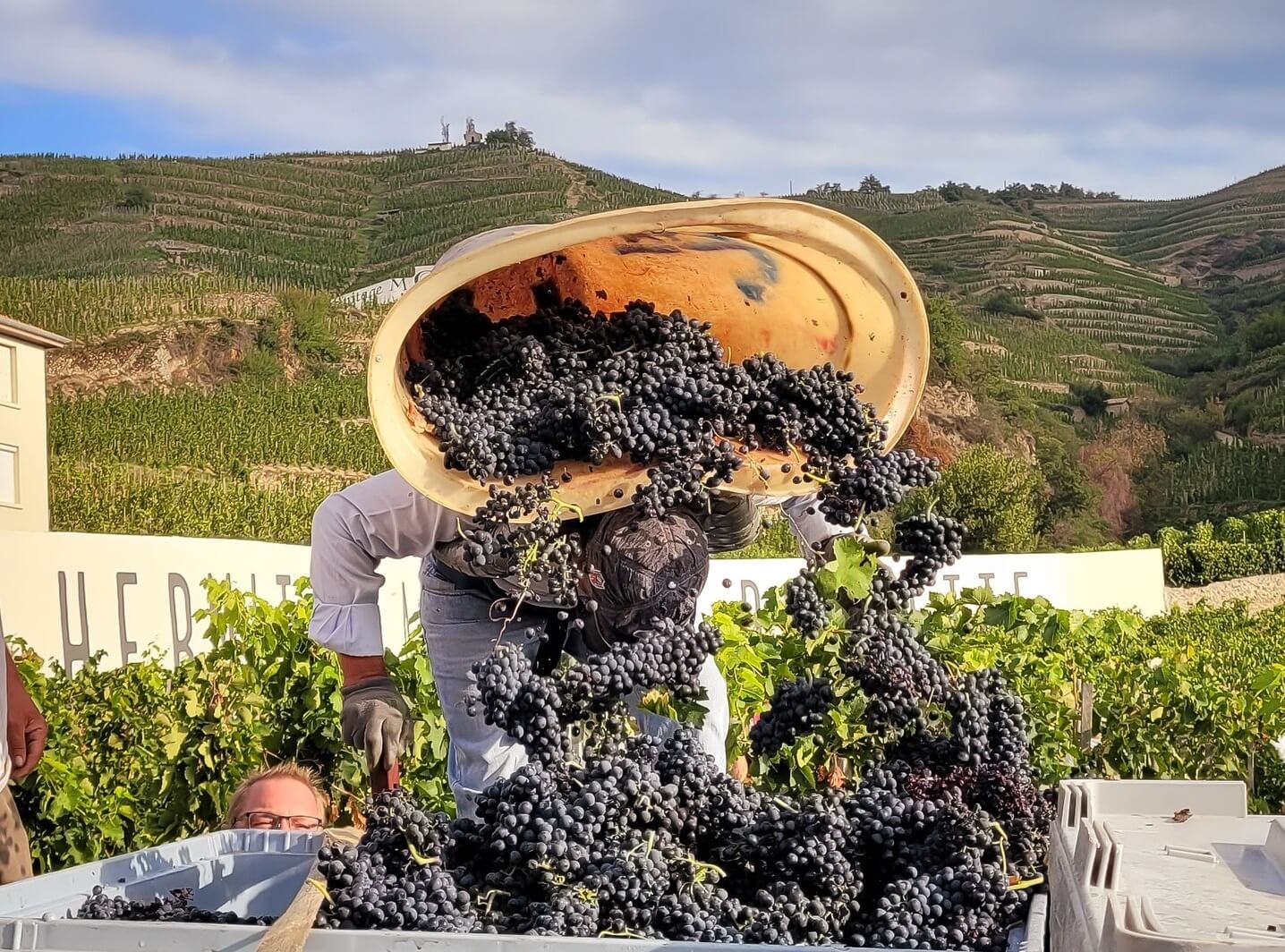
On Thursday 25 August, we had to already be ready to pick the Saint- Joseph hillside, kicking off the harvest of the northern Syrah. From Ampuis to Tain l’Hermitage, the ground had become covered in a carpet of purslane in a very short time, a sign that life was stirring again in the soil. Then, on the hillsides, a whole host of plants sprung up almost to the level of the clusters. At the end of August, the vineyard team had to cut back the vegetation on the slopes to maintain a well-aired environment and enable the grapes to reach perfect maturity. It was then that we realised that everything was starting up again, that the welcome rain of the last few days had caused the vine to resume its growth and the grapes to continue ripening. As the days went by, we tasted the grapes, the skins became thinner and the pulp came away from the pips. We waited patiently for the perfect balance!
Meanwhile, the picking of the whites continued smoothly on Friday 26 August with the Viognier in Chery, where the expression of the spicy aromas typical of very sunny vintages dominated over the varietal. Things were looking promising. On Monday 29 August, the team of pickers at the top of the Hill began harvesting the white l’Ermite which, as it lies at altitude, had been able to make the most of the heat. The days when we had to wait until the end of September to pick this plot seem a distant memory!
On Tuesday 30 August, an approaching storm had us worried, but in the end, it moved off to the other side of the Hill. The vegetation was kicking off again on all the plots, which was quite surprising at this stage in the season. Although the grape berries did not grow further in size, we had the impression, from the tasting, that good things were in the making on the granitic Terroirs.
At the end of August, just before another spell of rain, we went up to Ampuis to bring in the grapes from La Mordorée and Neve while they still retained a good balance. On the upside, the excellent phenolic maturities would set off the finesse and breeding of the Côte-Rôtie wines. While an unusually localised storm grazed the eastern side of l’Hermitage, the rest of the Hill remained dry as if a protective barrier had been erected. We had hoped for rain so much that we didn’t need much more of it now! On Sunday 4 September, the “Vendanges du Coeur“, a fabulous participative event, took place after a two-year hiatus. The Hill had transformed itself and the emerald green beautified the landscape.
Wednesday 7 September, as a “Cevenol episode” (heavy rainfall with flash flooding) was approaching in the distance, we began the picking in Varogne. The rain was never far off but, thanks to our weather tools, we were able to push on regardless, the clouds would move away to the Vercors. It seems the Hill really is protected!
On Thursday 8 September, we picked the Saint-Joseph, le Clos and Saint-Péray Payrolles, bringing in the last of the northern whites. On Monday 12 September, when many winegrowers had already cleaned and put away their secateurs, spring seemed to return to l’Ermite, offering us a bucolic tableau of a hilltop vineyard with the Rhône river winding its way through the landscape in the background. So, there we were, in mid-September, enjoying a new spring awakening, picking the l’Ermite grapes in some extraordinary light! After a few days’ wait, we brought in the Cornas Saint-Pierre on Thursday 15 September, a harvest of plenitude above the Rhône Valley’s banks of mist. 
On Tuesday 20 September, we were in Chabot, where the tiny spring flowers in the soil stand out against the autumnal foliage. Here we brought a very unusual vintage to a close, one that had been very sunny, of course, but which had so much more to it than that!
The vines on the granitic Terroirs remained largely impervious to the heat and the shortage of water and, as is often the case with this type of vintage, the cooler and later ripening high-lying Terroirs (Ermite, Cornas Saint-Pierre, etc.) fared well, whereas the young vines sometimes struggled to cope with the lack of water.
Thanks to the very gradual increase in the grapes’ sugar concentration levels, a repeat of the 2003 vintage, which all the winemakers had been worried about, did not occur. We were able to wait patiently for greater phenolic maturities while harvesting grapes with reasonable potential alcohol levels (13-13.5%), thus offsetting the moderate acidity levels.
Even if the profile of the 2022 vintage is broadly in line with other very sunny vintages, our patience has been rewarded, as the slow, gradual ripening at the start of September gave us even greater fullness and finesse.
The Marsanne shows reasonable alcohol levels (13-13.5%) and a surprisingly well-preserved acidity on the old vines, creating a lovely balance and good cellar-ageing potential. The brightness of the aromas will be this vintage’s hallmark feature. The Syrah are well-built, the alcohol levels are also reasonable (13-14%) and the balances fairly fresh. The wines possess a complexity and a noble austerity that gives them the capacity for long cellar-ageing.
In the Southern Rhône Valley, the Grenache grapes ripened more slowly, but the vines, which are used to a frequent lack of water (barely 172mm accumulated rainfall at the end of August) did not suffer, suggesting a nice potential on the Châteauneuf-du-Pape. The Syrah were harvested over the week of 23 August but we had to wait until Tuesday 30 August to pick Croix de Bois, which had been upset by the weather episode in mid-August. On Wednesday 14 September, we brought the harvest in the south to a close with Barbe Rac on its plateau of pebbles. The Grenache are already showing elegance and depth. The vintage was particularly well suited to vinifications which include some whole clusters of grapes (up to 30%), which create lovely fresh aromas and lusciousness on the mid-palate.
This year has gone to show that the wine producer is also able to learn and adapt to these very sunny vintages, both in the vineyards and in the winery, almost 20 years after the first of the very sunny vintages of the 21st century.


